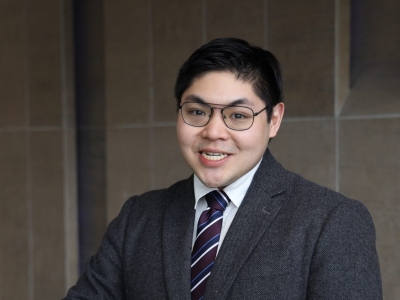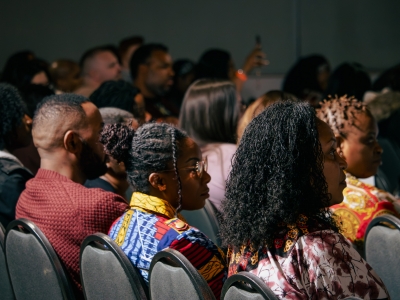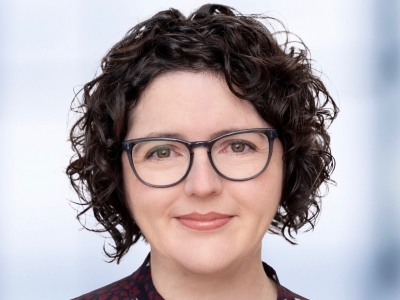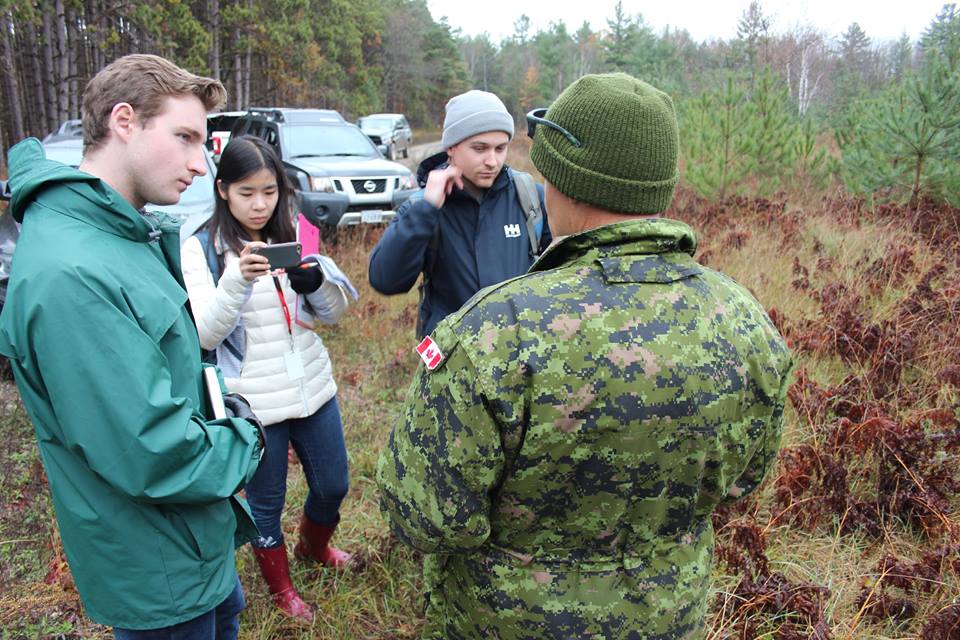
Carleton Journalism students interview a Canadian Forces member during a mock military exercise. (Photo: Allan Thompson)
By Levi Garber, Master of Journalism student
Traditionally, there was little preparation for journalists heading into war zones. But at Carleton’s School of Journalism and Communication, preparation for conflict reporting is taken seriously.
Our group of 25 students spent the last weekend in October at Canadian Forces Base Borden as embedded journalists in a war game exercise known as Exercise Ardent Defender.
This was the third time Carleton Journalism and Communications Professor Allan Thompson, who worked with the Toronto Star for 17 years before starting his teaching career, has collaborated with the military as part of a course on reporting from war zones.
“A couple of times in the past, I’ve approached the Department of National Defence and asked if there’s a war game exercise that the class could participate in,” explained Professor Thompson. “They agreed and insinuated us into their scenario. That way people got a semblance of what it would be like to be operating in a war zone or a hostile environment.”
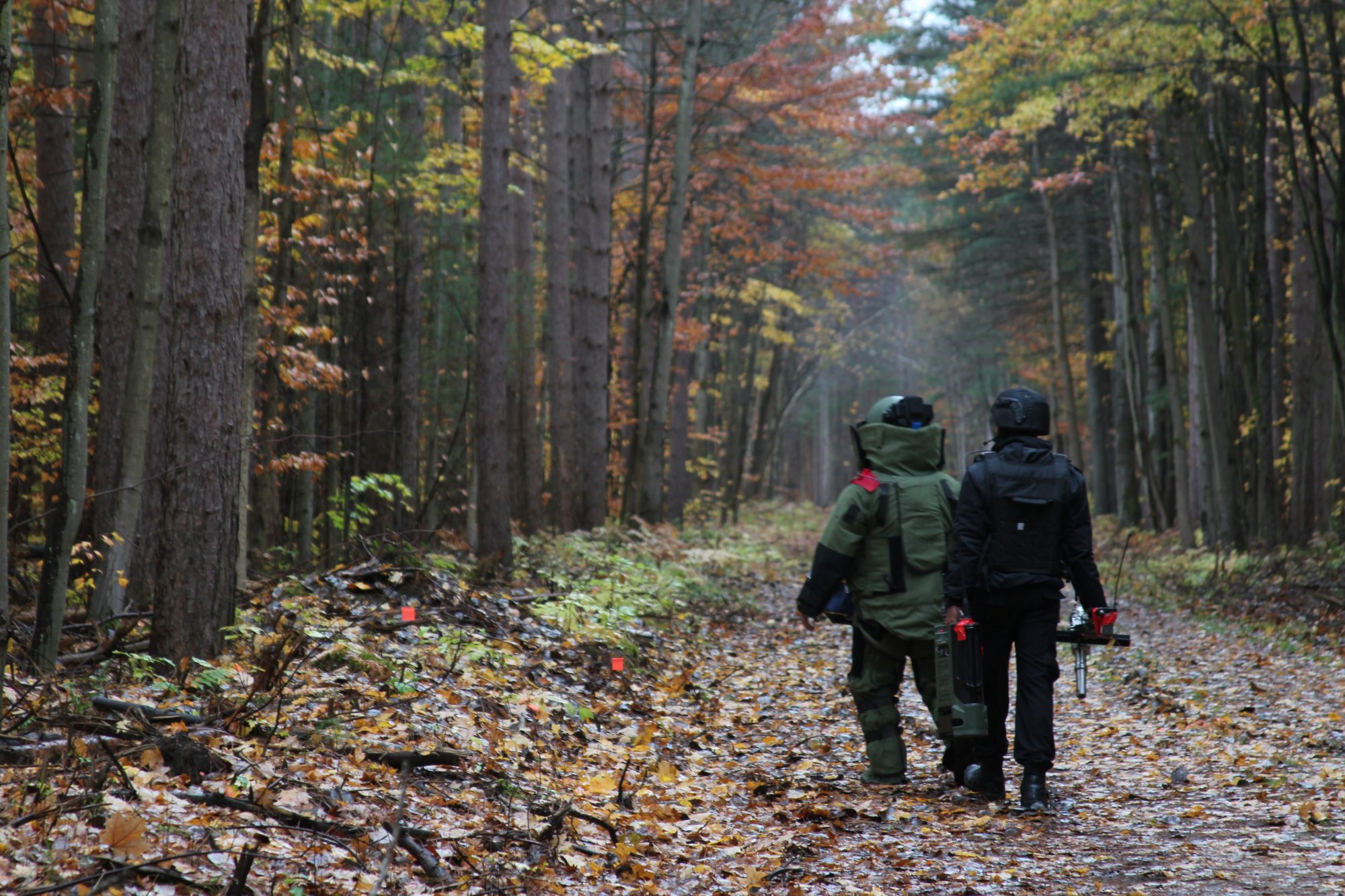
Members of an explosive diffusing team prepare to deal with a suspected IED planted by insurgents. (Photo: Allan Thompson)
Reporting on Fictional Conflict
For this year’s exercise, the Canadian Armed Forces hosted a mock deployment to the country of Goloka, where ethnic tensions between the ruling Golokans and minority Tomak people had led to an insurgency of guerilla warfare.
In the scenario, the Militant Alliance of Goloka, or MAG, an insurgency group with similar extremist goals to ISIS, had taken control of a Tomak rebellion and began an orchestrated improvised bombing campaign in the Golokan capital region of Borden. In response, Goloka requested the United Nations to intervene and send a peacekeeping mission to reassert stability.
Canada took the lead on the counter-explosive side of the conflict, working with 17 other countries. They all sent small groups of experts to take part in or observe the exercise and to find, identify and diffuse improvised explosives set up by MAG insurgents.
That’s where we journalism students came in.
We were split into groups of two or three students and embedded with bomb identification and diffusing teams and sent out to report on the unfolding conflict.
The experience was incredible.
“We stayed in tent structures that were pretty comparable to what embedded journalists would be using in Afghanistan and we had fairly austere conditions: it was cold, it was wet, and we were working long hours,” explained Professor Thompson. “People were up at 6:30 a.m. and had deadlines that ran until midnight two days in a row.”

A car explodes during the mock military exercise at Camp Borden. (Photo: Allan Thompson)
The events that unfolded in Goloka while we were embedded included a suicide car bomb in which the Canadian military actually blew up a car. They also staged a bus hijacking and hostage-taking incident.
Raisa Patel, a Carleton Master of Journalism student embedded with the range safety officer’s team and later with an explosive ordnance team, discussed why she thought the trip was a success.
“I really think that an experience like this is what education is all about. It’s the kind of practical, hands-on experience that places a lot of trust in you as a student to do a good job,” Patel said.
“My favourite part was getting to meet these people that, in general, tend to be a little closed off and secretive. You don’t get to interact with soldiers or members of the armed forces in this kind of intimate way. It was just a very unique experience.” — Raisa Patel
The trip received financial support from the Faculty of Public Affairs and Carleton University’s Discovery Centre. Both Master of Journalism students and fourth-year undergraduate students participated.
Mock Event, Real Explosions
All of the events that occurred during the weekend were staged. But for the soldiers participating, it was very much real life. The explosive diffusing teams were made up of technicians who are trained to work with live explosives — should they be deployed in a similar mission in the future.
The commanders and scenario controllers also treated the simulation as though the events were actually happening in order to train themselves for when they may be deployed for real.
Ash Abraham, another Master of Journalism student, said the experience taught her how much soldiers and journalists need to work together in conflict zones.
“I wanted to specifically take this course because I wanted to know if I had enough fire in my belly to be able to do war corresponding,” Abraham said. “I think it surpassed my expectations, in that I didn’t know how relational the job was going to be between the journalists and the military.”
“I didn’t realize how much time is spent getting to know other people in the field. That is something that I was surprised by,” she said.
After two nights sleeping in cold, damp tents and hectic typing to meet deadline, the 25 of us were ready to pack up Sunday morning and head back to Ottawa. It was a luxury the UN peacekeepers in Goloka would not enjoy for a few more days, when their three-week exercise finally wrapped up.
However, the experience will remain with most of us journalism students, as we consider if we have what it takes to report from a real war zone in the future.

Members of the Conflict Journalism class, led by Professor Allan Thompson (third from right). (Photo: Levi Garber)
Friday, November 17, 2017 in General, Journalism, News
Share: Twitter, Facebook

